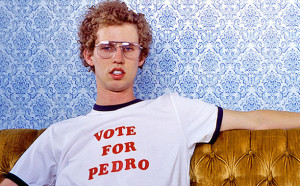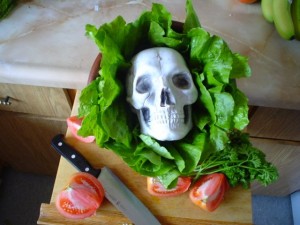In grade 12, I ran for high school president (we had grade 13 back then, and that’s me, right, exactly as shown).
 There were two assemblies, one for the juniors followed by one for the seniors, in which my opponent and I laid out our vision for the next school year.
There were two assemblies, one for the juniors followed by one for the seniors, in which my opponent and I laid out our vision for the next school year.
I had been one of the entertainment co-ordinators on the previous council, and somehow exceled at bringing in bands and making money (a little).
There was this thing called live music back then.
Our high school, I’m told, hosted early versions of Rush and Max Webster, and I brought in local stalwarts, Goddo, and, the best named band in the area, Teenage Head.
My worthy opponent spoke first at the junior assembly, and I followed with my band-a-month pitch, and a proposal to paint the school logo over the centre of the basketball court.
The senior assembly began with the same speaking order, and I was stunned – flummoxed – when my competition lifted the school-logo idea.
I mumbled something in my pitch about how she had lifted the idea, and quickly realized no one cared.
It didn’t matter who was first, it mattered that the idea was out there (I won, barely).
So I’ve watched with mild bemusement as the various outlets fall over themselves to claim they broke the Dole-knew-about-Listeria-in-its-lettuce-plant story.
 No one cares, just that it’s out there.
No one cares, just that it’s out there.
What matters more is what Dole is going to do about it.
And they’re not talking (I’ll have some suggestions this week).
In a similar vein, researchers have updated our 2004 Spot-the-Mistake study about the food safety foibles of celebrity chefs.
That’s 14 years after we did the original work and 12 years after we published the results.
Now that it’s out there, I can say the new analysis fails for two reasons: The researchers cite dubious references about how the majority of foodborne illness happens in the home; and they use FightBac’s severely limited cook-clean-chill-separate mantra as a tool for scoring, ignoring the World Health Organization’s extra warning of source food from safe sources.
Anyone who has ever watched a TV or web-based cooking show knows that most of the content consists of a host gassing on about the small, sustainable, organic, natural, dolphin-free farm where the ingredients were acquired.
Food safety behaviors observed in celebrity chefs across a variety of programs
Curtis Maughan, Edgar Chambers IV, Sandria Godwin,
J Public Health, doi: 10.1093/pubmed/fdw026
http://jpubhealth.oxfordjournals.org/content/early/2016/04/08/pubmed.fdw026.abstract
Background Consumers obtain information about foodborne illness prevention from many sources, including television media. The purpose of this study was to evaluate a variety of cooking shows with celebrity chefs to understand their modeling of food safety behaviors.
Methods Cooking shows (100 episodes) were watched from 24 celebrity chefs preparing meat dishes. A tabulation of food safety behaviors was made for each show using a checklist.
Results Proper modeling of food safety behaviors was limited, with many incidences of errors. For example, although all chefs washed their hands at the beginning of cooking at least one dish, 88% did not wash (or were not shown washing) their hands after handling uncooked meat. This was compounded with many chefs who added food with their hands (79%) or ate while cooking (50%). Other poor behaviors included not using a thermometer (75%), using the same cutting board to prepare ready-to-eat items and uncooked meat (25%), and other hygiene issues such as touching hair (21%) or licking fingers (21%).
Conclusions This study suggests that there is a need for improvement in demonstrated and communicated food safety behaviors among professional chefs. It also suggests that public health professionals must work to mitigate the impact of poorly modeled behaviors.
Mathiasen, L.A., Chapman, B.J., Lacroix, B.J. and Powell, D.A. 2004. Spot the mistake: Television cooking shows as a source of food safety information, Food Protection Trends 24(5): 328-334.
Consumers receive information on food preparation from a variety of sources. Numerous studies conducted over the past six years demonstrate that television is one of the primary sources for North Americans. This research reports on an examination and categorization of messages that television food and cooking programs provide to viewers about preparing food safely. During June 2002 and 2003, television food and cooking programs were recorded and reviewed, using a defined list of food safety practices based on criteria established by Food Safety Network researchers. Most surveyed programs were shown on Food Network Canada, a specialty cable channel. On average, 30 percent of the programs viewed were produced in Canada, with the remainder produced in the United States or United Kingdom. Sixty hours of content analysis revealed that the programs contained a total of 916 poor food-handling incidents. When negative food handling behaviors were compared to positive food handling behaviors, it was found that for each positive food handling behavior observed, 13 negative behaviors were observed. Common food safety errors included a lack of hand washing, cross-contamination and time-temperature violations. While television food and cooking programs are an entertainment source, there is an opportunity to improve their content so as to promote safe food handling.

